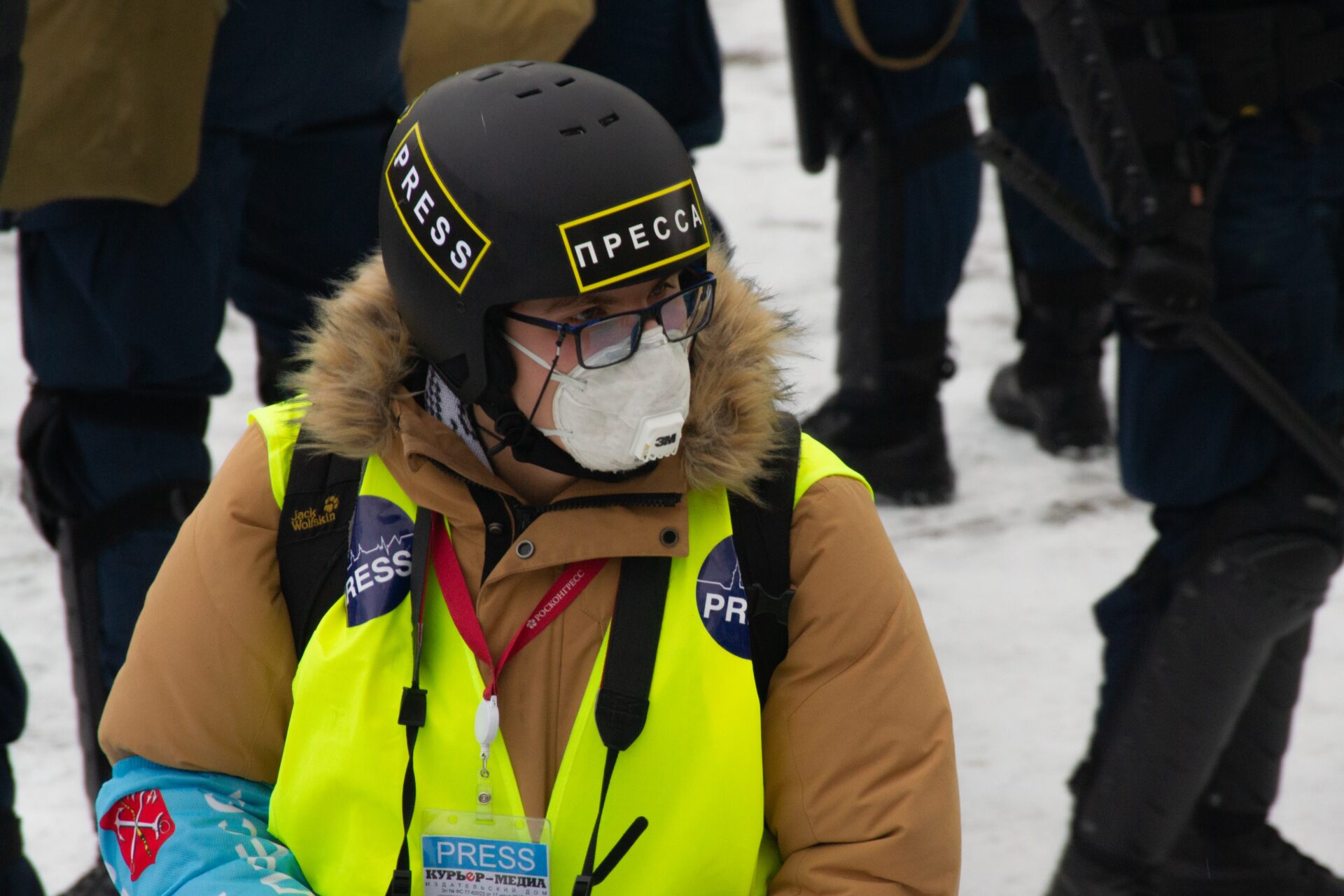Journalists who report on elections and democratic processes in the United States increasingly confront a range of legal, digital, and physical threats that can impact their mental health, physical safety, and reputation. The safety of journalists is a prerequisite for a free and diverse press that can connect with the communities it serves, but journalists cannot keep themselves safe alone and in isolation. Safety is a collaborative practice and collective responsibility, where newsroom managers have to lead.
The threats journalists face in our polarized society are complex and interrelated. Journalists contend with surging online abuse that often reverberates into their psychological and physical worlds. They face disinformation campaigns that threaten their reputation and the integrity of their reporting. Politicians routinely levy verbal at the media during their rallies, sometimes inciting crowds to violence against reporters. While reporting on the ground at local government meetings and polling stations, journalists can find themselves on the front lines, exposing them to physical risks from hostile crowds. All of these threats take place within the context of economic precarity across the media industry, as waves of layoffs can drive journalists to take on greater risks. Here we use the word “staff” expansively to include both the journalists employed by your newsroom as well as all the freelancers and contract workers your newsroom works with.
We have curated resources and organizations to help you build up practices and policies to keep the folks you work with safe, as well as tactical advice to navigate the risks and threats your staff may face while covering democracy.
Emergency Support
The Committee to Protect Journalists is an independent international nonprofit organization that promotes press freedom and defends the rights of journalists to do their work safely worldwide. They provide safety resources, advocacy and emergency assistance to journalists facing threats and attacks whether the attacks be online or offline.
Coalition Against Online Violence
Online Violence Response Hub
The response hub is a directory that connects newsrooms and journalists experiencing a broad range of online attacks (or concerned about being targeted online) with resources such as legal support, psychosocial support, and emergency assistance. Linked here are the resources specifically for newsrooms to support their staff.
Guides, Courses, Tip sheets and Checklists
ACOS Alliance
News Organizations Safety Self-Assessment
The ACOS (A Culture of Safety) Alliance, which brings together more than 100 newsrooms and press freedom organizations to collaborate on advancing journalist safety, developed this tool for newsrooms to assess the risks their organization and individual journalists face, and to then develop practices and policies to mitigate those risks.
Assignment safety checklist
This is a detailed list of items that staff, freelance journalists and editors should address before an assignment with an elevated risk of harm.
Model freelance contracts
While many people may not think of contracts when considering safety measures for journalists, the terms negotiated in contracts have a direct impact on reporter safety. They can determine what insurance coverage and protective equipment you have, who in the newsroom has your back and even what risks you’re willing to take. At times when covering breaking news, even the most safety-conscious editors can neglect to get a written contract in place with a freelancer, especially if it’s someone they’ve often worked with, but these signed contracts are critical for their safety should something go wrong. A Culture of Safety Alliance has put together ready-to-use sample contracts for freelancers, with an eye toward safety.
The Committee to Protect Journalists — Online and Offline
Covering elections: Journalist safety kit
When you have a question about journalist safety, the Committee to Protect Journalists, whose central mission is to protect journalists around the world, is always a great place to start. They have curated a package of resources for safe election coverage. This resource kit begins with a risk assessment template, which is one the most flexible tools that enables journalists to proactively identify and mitigate potential threats to their safety and the integrity of their reporting. By conducting thorough risk assessments, editors and reporters can make informed decisions about their coverage strategies, implement security measures and establish contingency plans, ultimately ensuring they can carry out their crucial role in safeguarding democracy while minimizing personal and professional vulnerabilities. Outside of the kit, the Committee to Protect Journalists has many other safety resources for journalists, including an editor’s checklist for protecting staff and freelancers against online abuse.
Dart Center for Journalism and Trauma
Leading Resilience: A Guide for Editors and News Managers on Working with Freelancers Exposed to Trauma
The Dart Center brings together mental health experts, journalists and educators to advance ethical reporting on violence, conflict and tragedy. This guide is an essential read for newsroom managers to fulfill their duty of care to the journalists they work with. While focused on freelancers, its guidance extends to staff employees as well and covers how managers can support their journalists before, during and after an assignment. It also discusses self-care for editors and managers.
Reporters Committee for Freedom of the Press
Election Legal Guide
Reporters Committee for Freedom of the Press is a U.S. organization that offers legal support to journalists. It’s the first place to look for resources on legal aid, knowing your rights as a reporter and the laws of covering elections. This guide put together for 2022 midterm elections provides legal information on exit polling, newsgathering around polling stations, ballot selfies and access to ballots and election records. It also provides more details on laws and regulations in Arizona, Florida, Georgia, Michigan, Minnesota, Nevada, New Hampshire, North Carolina, Ohio, Pennsylvania and Wisconsin.
PEN America
Online Harassment Field Manual — Best Practices for Employers
PEN America’s online harassment field manual is one of the first and most comprehensive guides on how to navigate the risks online violence poses to journalists and writers. This portion of the field manual offers guidance for managers and leadership to support their staff in the face of online abuse.
Ontheline Newsrooms — International Press Institute
Protocol for Newsrooms to Support Journalists Targeted with Online Harassment
This document gives newsroom leaders step-by-step guidance on how to support their staff facing online violence. It covers how to create a system for reporting abuse, how to conduct a risk assessment for online violence, how to implement support mechanisms and how to track abuse.
Thomson Reuters Foundation, UNESCO and International Women’s Media Foundation
Checklist and guidelines on gender-sensitive safety policies for newsrooms
This document was developed specifically for editors and managers to advance a culture of safety in their organizations that is inclusive of the experiences of their female and nonbinary journalists.
#NotOK — Canadian Broadcasting Corporation (CBC)
Newsroom Guide for Managing Online Harm
This guide, written by journalism safety expert Hannah Storm, advises newsrooms on how to manage the risks of online violence toward their staff before, during, and after online abuse occurs.
Assistance
These organizations offer a range of support to journalists — from legal aid to emergency funding to tip sheets — that reduce the risk of harm and help respond to threats.
A Culture of Safety Alliance is a coalition of more than 150 newsrooms, press freedom NGOs and journalists around the world working together to embed a culture of safety in journalism.
International Women’s Media Foundation focuses on empowering and protecting female and nonbinary journalists globally. They offer training support to newsrooms to develop safety policies. They are offering one- and two-day safety workshops to newsrooms in swing states through their “News Safety Across America” program.
International News Safety Institute is a membership organization dedicated to journalist safety that promotes information sharing and collaboration across its members, which consist of broadcast, print and digital outlets.
PEN America is dedicated to protecting and promoting freedom of expression. They advocate for the rights of journalists, writers and artists and offer resources, including training for newsrooms on online safety to protect free speech.
Freedom of the Press Foundation works to defend and support journalism in the digital age. They provide tools, resources and training for independent journalists and news organizations looking to enhance their digital security and protect their online presence and assets.
Coalition Against Online Violence brings together dozens of NGOs and other international organizations committed to supporting journalists who face online abuse and harassment. Through the Online Violence Response Hub, it provides guides and assistance to people experiencing violence online.
Reporters Committee for Freedom of the Press is a U.S.-based organization provides legal resources and support to journalists facing legal challenges or threats to their safety. If you need emergency assistance, contact their legal hotline.
Troll Busters has been providing safety training, security advice, and direct support to journalists facing threats on and offline for more than a decade. Their site also has many resources on digital hygiene, mental wellbeing, and personal safety.
Media Defence is a U.K.-based organization that offers emergency aid and legal representation around the world to journalists facing legal harassment.
Lawyers for Reporters is an organization that offers pro bono legal services to local newsrooms around the U.S.
The Dart Center for Journalism and Trauma is focused on the intersection of journalism and trauma. It provides resources, training and support for journalists dealing with traumatic experiences while reporting.
Headlines Network, founded and run by journalists, works with newsrooms to promote the mental health and wellbeing of journalists. They offer trainings and consulting to newsrooms aimed at improving mental health.
Global Press News Services, along with being a publisher and news service, offers safety and security consultations to newsrooms to implement duty of care programs.
AccessNow is an international NGO focused on promoting digital rights and freedoms worldwide. Its helpline offers support 24/7 to media organizations, journalists, activists, and human rights defenders experiencing online attacks.
Nothing 2 Hide provides emergency digital assistance to journalists, activists, and civil society organizations through its digital security helpline. The organization also offers digital security training.
Free Press Unlimited advocates for the rights of journalists around the world and offers emergency support to journalists and newsrooms who are targeted because of their work. Their support includes medical assistance, short term relocation costs, legal defense support, psychosocial support and security advice.
Additional Resources
The Journalist’s Resource
“6 tips from IRE panel on making safety part of newsroom culture” by Naseem S. Miller
Article
International Press Institute
“Editors’ responsibility in shielding journalists from impact of online abuse” by Markuu Huusko
Video
World Association of News Publishers
“The Backstory – Managing safety: What editors can do to keep journalists safe” by Andrew Heslop
Podcast




